Mago Nashi, Tsunagi/Y14, and Ranshi form a complex that influences oocyte differentiation in Drosophila melanogaster
- PMID: 20045686
- PMCID: PMC2852135
- DOI: 10.1016/j.ydbio.2009.12.035
Mago Nashi, Tsunagi/Y14, and Ranshi form a complex that influences oocyte differentiation in Drosophila melanogaster
Abstract
During Drosophila melanogaster oogenesis, a germline stem cell divides forming a cyst of 16 interconnected cells. One cell enters the oogenic pathway, and the remaining 15 differentiate as nurse cells. Although directed transport and localization of oocyte differentiation factors within the single cell are indispensible for selection, maintenance, and differentiation of the oocyte, the mechanisms regulating these events are poorly understood. Mago Nashi and Tsunagi/Y14, core components of the exon junction complex (a multiprotein complex assembled on spliced RNAs), are essential for restricting oocyte fate to a single cell and for localization of oskar mRNA. Here we provide evidence that Mago Nashi and Tsunagi/Y14 form an oogenic complex with Ranshi, a protein with a zinc finger-associated domain and zinc finger domains. Genetic analyses of ranshi reveal that (1) 16-cell cysts are formed, (2) two cells retain synaptonemal complexes, (3) all cells have endoreplicated DNA (as observed in nurse cells), and (4) oocyte-specific cytoplasmic markers accumulate and persist within a single cell but are not localized within the posterior pole of the presumptive oocyte. Our results indicate that Ranshi interacts with the exon junction complex to localize components essential for oocyte differentiation within the posterior pole of the presumptive oocyte.
Copyright 2009 Elsevier Inc. All rights reserved.
Figures
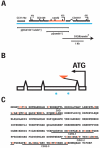
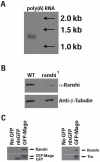

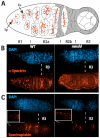
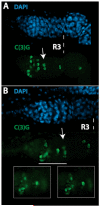


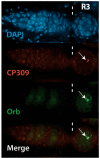
Similar articles
-
Mago Nashi and Tsunagi/Y14, respectively, regulate Drosophila germline stem cell differentiation and oocyte specification.Dev Biol. 2007 Aug 15;308(2):507-19. doi: 10.1016/j.ydbio.2007.06.007. Epub 2007 Jun 13. Dev Biol. 2007. PMID: 17628520 Free PMC article.
-
The RNA-binding protein Tsunagi interacts with Mago Nashi to establish polarity and localize oskar mRNA during Drosophila oogenesis.Genes Dev. 2001 Nov 1;15(21):2886-99. doi: 10.1101/gad.927001. Genes Dev. 2001. PMID: 11691839 Free PMC article.
-
Drosophila Y14 shuttles to the posterior of the oocyte and is required for oskar mRNA transport.Curr Biol. 2001 Oct 30;11(21):1666-74. doi: 10.1016/s0960-9822(01)00508-5. Curr Biol. 2001. PMID: 11696323
-
[Source of asymmetry in ontogeny: early polarization of the germline cyst and oocyte in Drosophila].Genetika. 2008 Sep;44(9):1157-71. Genetika. 2008. PMID: 18846812 Review. Russian.
-
Axis formation during Drosophila oogenesis.Curr Opin Genet Dev. 2001 Aug;11(4):374-83. doi: 10.1016/s0959-437x(00)00207-0. Curr Opin Genet Dev. 2001. PMID: 11448623 Review.
Cited by
-
Twenty-seven ZAD-ZNF genes of Drosophila melanogaster are orthologous to the embryo polarity determining mosquito gene cucoid.PLoS One. 2023 Jan 3;18(1):e0274716. doi: 10.1371/journal.pone.0274716. eCollection 2023. PLoS One. 2023. PMID: 36595500 Free PMC article.
-
Slow co-evolution of the MAGO and Y14 protein families is required for the maintenance of their obligate heterodimerization mode.PLoS One. 2014 Jan 8;9(1):e84842. doi: 10.1371/journal.pone.0084842. eCollection 2014. PLoS One. 2014. PMID: 24416299 Free PMC article.
-
The mRNA dynamics underpinning translational control mechanisms of Drosophila melanogaster oogenesis.Biochem Soc Trans. 2024 Oct 30;52(5):2087-2099. doi: 10.1042/BST20231293. Biochem Soc Trans. 2024. PMID: 39263986 Free PMC article. Review.
-
Potential molecular mechanisms for fruiting body formation of Cordyceps illustrated in the case of Cordyceps sinensis.Mycology. 2017 Aug 30;8(4):231-258. doi: 10.1080/21501203.2017.1365314. eCollection 2017. Mycology. 2017. PMID: 30123644 Free PMC article.
-
Innovation of heterochromatin functions drives rapid evolution of essential ZAD-ZNF genes in Drosophila.Elife. 2020 Nov 10;9:e63368. doi: 10.7554/eLife.63368. Elife. 2020. PMID: 33169670 Free PMC article.
References
-
- al-Mukhtar KA, Webb AC. An ultrastructural study of primordial germ cells, oogonia and early oocytes in Xenopus laevis. J. Embryol. Exp. Morphol. 1971;26:195–217. - PubMed
-
- Bolivar J, Huynh JR, Lopez-Schier H, Gonzalez C, St Johnston D, Gonzalez-Reyes A. Centrosome migration into the Drosophila oocyte is independent of BicD and egl, and of the organisation of the microtubule cytoskeleton. Development. 2001;128:1889–1897. - PubMed
-
- Brayer KJ, Segal DJ. Keep your fingers off my DNA: protein-protein interactions mediated by C2H2 zinc finger domains. Cell Biochem. Biophys. 2008;50:111–131. - PubMed
-
- Brown RS. Zinc finger proteins: getting a grip on RNA. Curr. Opin. Struct. Biol. 2005;15:94–98. - PubMed
-
- Büning J. The Insect Ovary: Ultrastructure, Previtellogenic Growth and Evolution. Chapman & Hall; New York: 1994.
Publication types
MeSH terms
Substances
Grants and funding
LinkOut - more resources
Full Text Sources
Molecular Biology Databases

